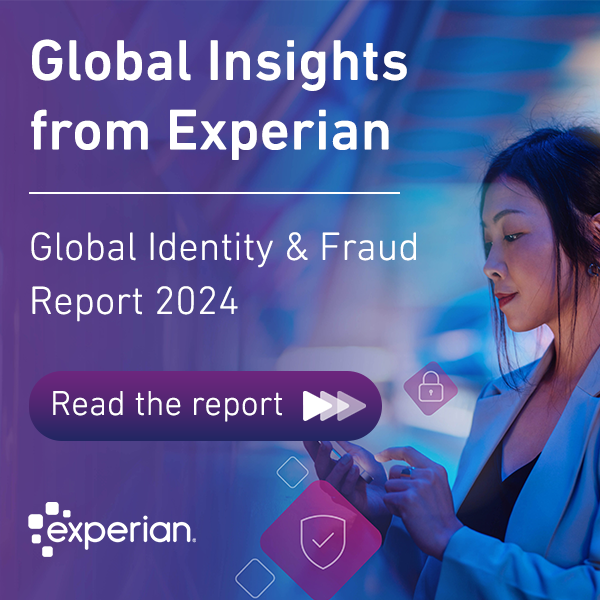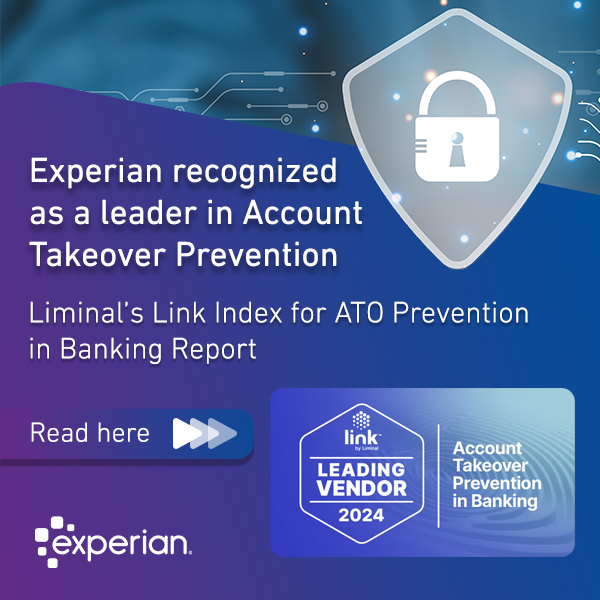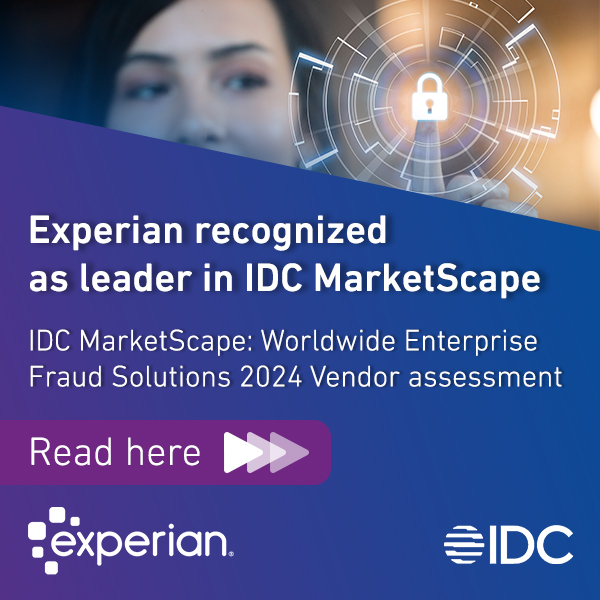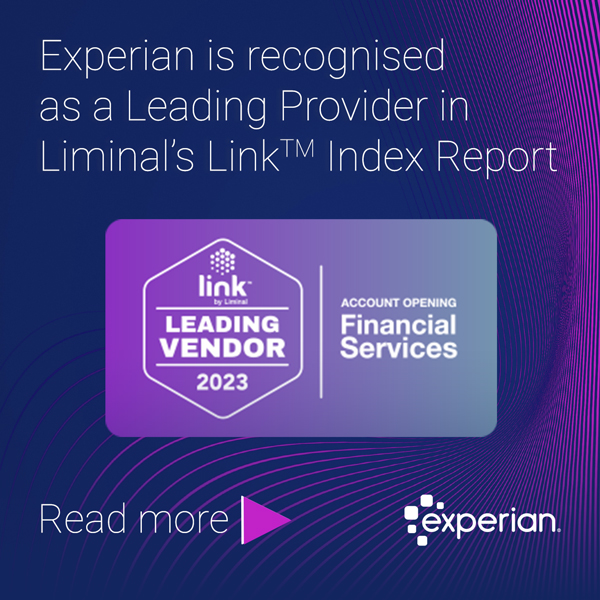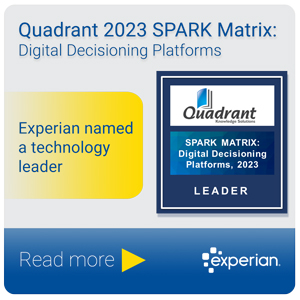All posts by Managing Editor, Experian Software Solutions

Getting the most out of your AI investment Work backward from impact - give yourself room to experiment Hire the best data talent and partner with the right provider Take a holistic approach - don't just focus on performance AI allows businesses to process sheer volumes of data and multi-tiered models with extreme speed and efficiency. But, scaling AI to meet shifting business demand can be challenging. Experian's Ascend Intelligence Services expertly partners with organizations to build custom, scalable AI and ML solutions to meet those requirements. Listen to Shri Santhanam advise on how to scale AI

Why digital acceleration has created more opportunities for deepfake fraud tactics like voice cloning and what businesses can do about it Digital acceleration has placed information and services in the hands of the masses, connecting individuals on a global level like never-before, and in turn making them increasingly dependent on devices in their daily lives. The argument for technology as an equalizer in society is a strong one. Most people have a voice and a platform, producing millions of virtual interactions and recordings every day. But in this digital world of relative anonymity, it is difficult to know who is really on the other side of the connection. This uncertainty gives fraudsters an opening to threaten both businesses and consumers directly, especially in the realm of deepfakes. What is a deepfake? Deepfakes are artificially created images, video and audio designed to emulate real human characteristics. Deepfakes use a form of artificial intelligence (AI) called deep learning. A deep learning algorithm can teach itself how to solve problems using large sets of data, swapping out voices and faces where they appear in audio and video. This technology can deliver extraordinary outcomes across accessibility, criminal forensics, and entertainment, but it also allows a way in for cybercriminals that hasn’t existed until now. Deepfake fraud tactics A principal tactic among deepfake fraud is voice cloning – the practice of taking sample snippets of recorded speech from a person and then leveraging AI to understand speech patterns from those samples. Based on those learnings, the modeler can then use AI to apply the cloned voice to new contexts, generating speech that was never spoken by the actual voice owner. For businesses, deepfake tactics such as voice cloning means access to points of vulnerability in authentication processes that can put organizations at risk. Fraudsters may successfully bypass biometric systems to access areas that would otherwise be restricted. For government leaders, it can mean the proliferation of misinformation – a growing area of concern with huge repercussions. For consumers, the risk of falling victim to scams involving access to personal information or funds is particularly high when it comes to voice cloning. How to prevent deepfake fraud 1. Vigilance: Stay on top of sensitive personal information that could be targeted. Fraudsters are always at work, relentlessly seeking out opportunities to take advantage of any loophole or weak spot. Pay close attention to suspicious voice messages or calls that may sound like someone familiar yet feel slightly off. In an era of remote work, it is important to question interactions that can impact business vulnerabilities – could it be a phishing or complex social engineering scam? 2. Machine learning and advanced analytics: Deepfake fraud is an emerging threat, which leverages the development and evolution of the technology that fuels it. The flip side is that businesses can in fact use the same technology against the fraudsters, fighting fire with fire by deploying deepfake detection and analysis. 3. Layered fraud prevention strategy: Leveraging machine learning and advanced analytics to fight deepfake fraud can only be effective within a layered strategy of defense, and most importantly, at the first line of defense. Ensuring that the only people accessing the points of vulnerability are genuine means using identification checks such as verification, device ID and intelligence, behavioral analytics, and document verification simultaneously to counter how fraudsters may deploy or distribute deepfakes within the ecosystem. As with many types of fraud, staying one step ahead of the fraudsters is critical. The technology and the tactics continually evolve, which may make the countermeasures on the table right now obsolete, however the fundamentals of sound risk management, with the right layered approach, and a flexible and dynamic solution set, can mitigate these emerging threats. Stay in the know with our latest research and insights:

Fraud threats continue to rise across the globe as consumers are spending record amounts of time online due to the pandemic. At the same time, emerging threats of fraud are growing, as fraudsters are taking advantage of the globally shifting economic conditions. Fraud prevention remains a top concern for both consumers and businesses alike. Anticipating future fraud risk is critical and companies are adopting more complex technology systems to ensure consumers’ financial safety. To provide a safe and convenient experience, businesses need to take a customer-first approach when evaluating the latest technology and solutions available to them. To ensure they are providing secure online experiences, businesses are turning to verification strategies using data technology and other detection methods. In fact, according to this year’s Global Identity and Fraud Report, customer recognition security strategies have become the new norm for businesses with 82 percent of companies saying they now have one in place, a 26 percent increase since the start of the pandemic. An independent research firm headquartered in Germany, KuppingerCole Analysts, released a report, Leadership Compass: Fraud Reduction Intelligence Platforms, that provides an overview of the market segment, vendor service functionality, prevention measures and innovative solutions to fraud. The report cites Experian as an overall leader, product leader, innovation leader, market leader and technology leader in fraud reduction intelligence platforms. Experian is also credited for taking a client-oriented upgrade approach and delivering other cutting-edge features while maintaining compatibility with our older platform releases. We also scored a strong positive for interoperability, usability, deployment, innovativeness, market position, financial strength and ecosystem; and a positive in security and functionality. We pride ourselves in our digital identity protection services and consumer safety, taking proactive approaches to fraud prevention and providing businesses with the necessary tools to identify risks of fraud. The report discusses fraud prevention measures and innovative solutions to fraud. According to the report, cybercrime costs will reach $10.5 trillion by 2025. The report evaluated 15 different data security and fraud prevention platforms and ranked their products, innovation, market positioning and technology in their report. All of Experian’s fraud detection and prevention services are available through our CrossCore® partner ecosystem. By combining advanced analytics, rich data assets, identity insights and fraud prevention capabilities, businesses can connect any new or existing tools and systems in one place, whether it be Experian’s, Experian’s partners or its own. With its built-in strategy design and enhanced workflow, fraud and compliance teams have more control to quickly adjust strategies based on evolving threats and business needs, which helps to improve efficiency and reduce operational costs. Learn more about the CrossCore platform. Stay in the know with our latest research and insights:

How elite leaders train analytics teams to unearth and convey the highest quality data insights and better manage risk. It's surprising how much of an art the effective use and analysis of qualitative data in the business world truly is. Too often, data scientists are tasked with turning raw data into insights without ever actually being taught the true art of identifying and reporting the most meaningful insights that address the problems at hand. Instead, data teams often produce reams of summarized information without drawing any useful conclusions – falling short of discovering deeper truths hidden within. I've been fortunate to work for, with, and manage data scientists of various titles, abilities, and personalities over the years. I've found that the true "artists" in this profession can combine technical proficiency, tactical communications with an affinity for the science, and excellent detective skills. Objectivity in Data Analysis As Arthur Conan Doyle wrote in Sherlock Holmes says, "I never guess. It is a capital mistake to theorize before one has correct data. Insensibly one begins to twist facts to suit theories, instead of theories to suit facts." As data scientists, we're often sent down a singular path to analyze data to support a narrative. Data is inherently objective; analyzing with subjective intent typically leads to ineffective results when put into practice. However, with the proper guidance, probing questions, and some detective work, scientists can uncover deeper insights leading to effective outcomes in the form of actionable intelligence and forecasts. Early in my career, I was tasked by a business partner to pull data that demonstrated higher customer satisfaction scores for a customer call center. Requests like this – "just get me the data" – are (unfortunately) common. In this case, however, he was open to discussing the "why" behind his ask. As a result, this incident proved a learning opportunity for me on how to satisfy a requirement while simultaneously producing information explicitly valuable to the organization. I've often had to find workable paths through figurative minefields with mandates such as "just get me the data" or "make the numbers work." During this scenario, I diligently asked ancillary questions to build into the data modeling outside the required parameters. I intended to generate value beyond the pre-conceived conclusion I was tasked with finding data for. The resulting report yielded compelling insights, actionable intelligence, and a clear forecasting plan. In this example, it was found that clients had higher satisfaction scores for reasons other than what we initially thought and had nothing to do with the seven million dollars my business partner spent on branding, training, etc. The solution was simple: move a training location. Tactical communication skills were necessary in this scenario as I had to tell my business partner where the efficiency gains were actually coming from and where future budgets could be more effective. Doing so was the catalyst behind an alternative business strategy and focus, resulting in a much more significant impact on our customer relationships. Asking the Right Questions The true purpose of analytics is to discover, interpret, and communicate meaningful patterns in data and the connective tissue between. Most importantly, it exists to aid in effective decision-making within an organization. Under that premise, I teach my teams to be communicative, especially during planning stages and consistently ask questions of the data throughout the analytical process. It's always imperative to identify the specific addressable problems our clients are trying to solve while frequently conversing with them to understand what actions and/or decisions the analysis is meant to inform. This strategy produces more profound results and focuses on solving a problem – not endlessly cycling through various cuts of the same data. As a result, the team will be primed to evaluate results objectively and be ready to dig beyond surface-level data, capturing vital insights hidden deep within. Using the Right Tools Nobody does arithmetic by hand anymore. A data scientist's best friend should be sophisticated model development software that leverages AI and Machine Learning. The efficiency they provide enables us to focus on areas where human intelligence is best applied, such as interpreting model performance within the context of how that model will be used. Elite leaders know how to leverage the right tools to maximize speed and efficiency. Ignoring the sheer processing power of cloud computing and other advancements places your organization at a distinct competitive disadvantage in performance and accuracy. I shudder when thinking about the dark days when it would take six to nine months to develop a new model. It reminds me of watching NASA mathematicians do advance calculations with slide rules in movies like Apollo 13 and Hidden Figures. Strategy optimization is a perfect example; how do I ensure that my portfolio is holistically delivering the highest value within risk constraints? I could grow my portfolio endlessly, but that likely means taking on too much back-end risk. Instead, mathematical optimization can be used to determine the right balance between growth, return, and risk. To do this successfully requires a vast amount of processing power. Gradient boosting, a Machine Learning technique that helps build far more accurate models, is another excellent example of what's possible with modern technology. Some of the operations we perform daily were literally not possible 10-15 years ago as we did not have access to such processing power. Thus, we're able to solve problems not previously solvable. What has also changed is our ability to process volumes of data and highly complicated, multi-tiered models, with extreme speed and efficiency. Organizations don't need to take all of this on, as companies like Experian effectively provide data science services where AI/ML solutions are delivered rapidly and digitally. A well-equipped, efficient, curious, and well-trained data team whose data analysis consistently helps corporate leaders make informed decisions is true art. The answers they provide to challenging business questions is their magnum opus. Read about topics related to this article Stay in the know with our latest research and insights:

Did you miss these August business headlines? We’ve compiled the top global news stories that you need to stay in-the-know on the latest hot topics and insights from our experts. Categorizing Fraud Types is the Key to Addressing Risk Security Magazine's Chris Ryan uses Experian research to break down why businesses need to first identify and understand the individual types of fraud before being in the position to address risk, especially when operating in an increasingly digital age. How To Protect Yourself Against Scammers and Deepfakes In this video, Philip Michael of Bold TV talks to David Britton, VP of Industry Solutions, about what fraud looks like in an AI-driven world, what exactly Deepfakes are, how they can be used in financial scams, and how Experian is using tools like AI and ML to fight back. Today’s Credit Decisioning: Navigating the Current Complexities The science of consumer credit decisioning is complex, writes Harry Singh, SVP of Global Decisioning, for Credit Union Times, but what has the pandemic done to further these complexities? This piece explains why lenders need to rethink existing models and processes to succeed in changing times. Experian Named Top Fraud Prevention Leader in International Analyst Report Research from KuppingerCole lists Experian as an overall leader in fraud reduction intelligence platforms. The research also recognized leadership in product, market and innovation, and across all other categories. Read about why this is important as fraud risks rise. How To Combat Fraudsters As The Digital World Grows In this piece for CEO World, David Britton, VP of Industry Solutions, writes about the relentless nature of fraud and why the goal of fraudsters never changes, and what businesses and individuals must to in the face of an ever-evolving fraud landscape in an increasingly digital world. Stay in the know with our latest research and insights:
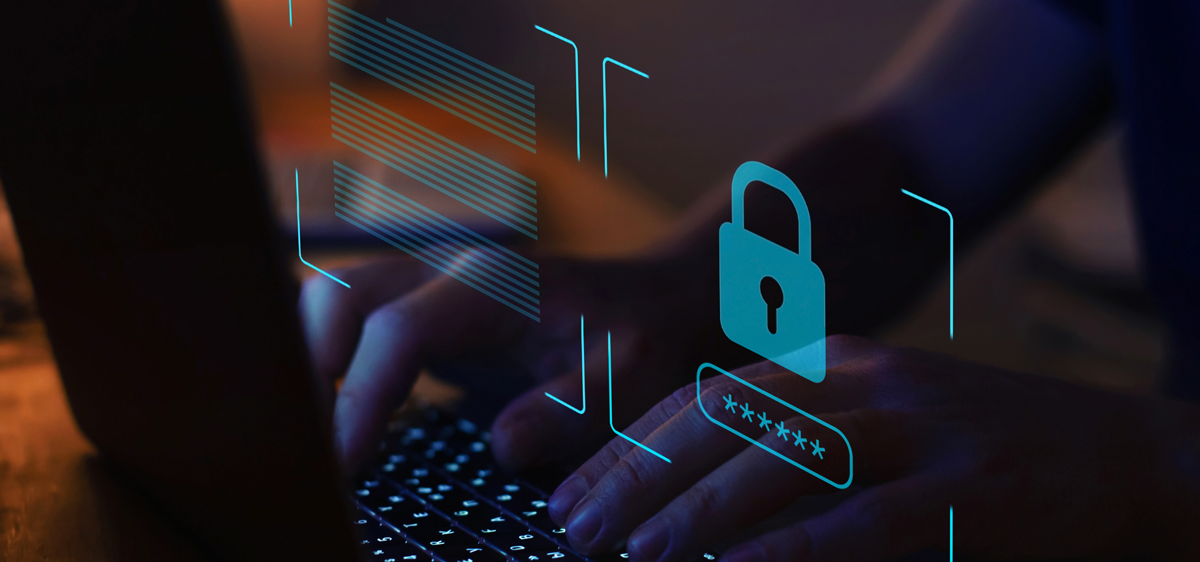
In this opinion piece on CEO World, David Britton, VP of Industry Solutions, Global ID & Fraud, discusses why, in today's increasingly digital world, it is much easier for fraudsters to operate on a global scale. As commerce and financial services ramped up their online offerings due to the pandemic, it enabled criminals to take advantage of people in vulnerable situations. There has been a significant shift away from previously prevalent fraud schemes such as account takeover, account opening and card-not-present, towards the direct manipulation of individuals to get to their personal information and payment details. "Not only have they been taking over the world, but fraudsters have been taking advantage of the growing digital environment, and as recent research from Experian found, 55% of consumers say security is the most important factor in their digital experience. It is important for individuals to know what to do to ensure that their information is secure and to have technology to utilize in order to fight against this issue. For both personal and businesses, there are ways to combat the scandals of fraudsters." Business fraud prevention With a focus on ransomware and email compromise, there are many things businesses can do to minimise vulnerability to fraud. A layered approach to defence is key, along with device intelligence and strong employee training. Personal financial fraud Although there is a common misconception that credit card details pose the biggest fraud opportunity, identity theft is by far the one to watch for consumers today. Fraudsters can use personal information for credit or payments. "Businesses must invest in new technologies in order to give people the added security they desire when accessing their accounts. In fact, according to our most recent Global Identity & Fraud Report, consumers no longer believe passwords are the most secure method for authentication. Since the pandemic, consumers have an increasing level of comfort and preference for physical and behavior-based – or invisible – methods of security." Read the full article Stay in the know with our latest insights:

Fraud has been exacerbated by the Covid pandemic, and with total cybercrime costs set to reach $10.5 trillion by 2025 according to Cybersecurity Ventures*, many businesses are looking to protect themselves and their customers from fraudsters. As the world moves further towards digital interactions across services and eCommerce, new fraud targets are emerging, and although financial services are more accustomed to these attacks compared with new targets, they are still favorites among the criminals. KuppingerCole's Leadership Compass report on fraud reduction intelligence platforms, highlights Experian as a leader across product, innovation and market. *Cybersercurity Ventures

The pandemic has impacted everyone differently. With consumers emerging from the crisis with very different credit needs, we take a look at how lenders can navigate an uneven economic recovery when it comes to credit risk decisioning. Download the full Global Decisioning Report: Navigating a new era of credit risk decisioning.

A recent industry-leading analyst report looking at loan origination solutions found that lenders are experiencing high volumes of new loan applications, but many are struggling to process them. This alongside increased consumer demand for improved digital experience, and a shifting credit landscape means lenders are trying transform both to keep operating costs down and meet the needs of a changing market. This tracks closely to findings from our Global Decisioning Report 2021. We look at what is changing, and how the Now Tech: Loan Origination Solutions report advises lenders to move forward. Consumers went online, and have high expectations of the digital experience The pandemic shut down banking and retail locations around the world. Amidst the lockdown, consumers turned online to manage finances, connect with lenders, and buy essential goods and services. The crisis especially accelerated digital adoption for older consumers and created a new digital imperative for lenders wanting to meet customers’ evolving needs. The rise of self-service and new payment methods There was also an increase in the already growing demand for digital self-service in terms of applying for credit and seeking out repayment support. Consumers expect to be able to apply for credit when and where they need it, often using a mobile-friendly device. In return for convenience and security, consumers report that they’re more willing to provide additional personal data. Timely, meaningful credit and repayment offers, convenient interactions, and improved communication with lenders make the exchange worth it. The convenience of digital channels is also creating the opportunity for new payment methods, such as subscription models and Buy Now Pay Later (BNPL). Both are occurring across a range of products and services, from cars to clothes to beauty essentials. Our Global Decisioning Report found that 27% of consumers reported purchasing products using BNPL programs. Traditional lenders will need to consider the needs that the emerging BNPL market meets. This includes making purchases easier for consumers by providing increased payment flexibility. APIs, security, integration, and explainable AI According to the Now Tech report, lenders should look for solutions that allow access to data via APIs for credit decisioning, have strong data security and privacy practices, integrate with third-party technology products and services, and leverage explainable AI for underwriting. Allowing lenders to acquire customers digitally is key, and loan origination solutions provide a digital portal that can be accessed across devices and which supports real-time customer input, document uploads, data aggregation and analysis, and digital signatures. Want to read the full 2021 Global Decisioning Report?

Financial institutions have long been dependent on technology for business operations, resulting in a long history of tech additions, upgrades and vendors. Changes made to legacy IT systems can not only impact customers, but in many cases, the economy too. Often these systems feel safe and familiar, so it can be a difficult choice to make a change. However, over the last year the pandemic has highlighted the need for agility within the market. Responding to changing customer needs in an increasingly digital environment is number one priority. What do we mean by legacy tech? The term legacy tech has a lot of negative connotations. It refers to a set of computer systems, software and technologies that can no longer be maintained or easily updated. The system could be out of support or in extended support. Integration becomes a challenge because different technologies have accumulated over the lifespan of the business, and the associated support levers around it are all different. There is also the challenge of finding the skills to maintain these systems – in-house or outsourced from providers. Maintenance costs can be high – security and resilience test costs will add to this, while performance will drop with the increasing need for work-arounds. Upgrades can be complex, expensive or even impossible on legacy systems, generating extra costs. Financial institutions create their own legacy systems when they start integrating various data sets from different sources. It can happen when the business grows to new locations, new lines of product, extended consumer services, while using different tech from different vendors. Cloud as an enabler for business transformation From the moment code is written and deployed, it becomes legacy. Cloud integration allows for daily code releases and automated upgrades meaning that businesses are constantly adjusting and responding to client needs, regulation and strategic changes. They can instead focus on their business model and innovation, staying relevant and up to date. Budget is directed towards improvements and innovation instead of maintaining the legacy tech. It brings an interesting level of agility, with the ability to respond to the market much more quickly and effectively. How cloud can benefit the customer Cloud-based services have allowed banks to revolutionize onboarding processes and timescales. Processes like KYC (Know Your Customer) can be carried out by partners for a fast and efficient experience. Throughout the lifecycle of a customer, banks can leverage third parties for every part of the journey and ultimately improve customer experience. Beyond the onboarding process, the entire customer lifecycle, from originations to collections, can be transformed by removing friction and using AI to create interest, and ML to make decisions for quick results. Experian has partnered with Open Banking Expo TV to produce a series on Cloud-based solutions. Sign up to watch. Related content
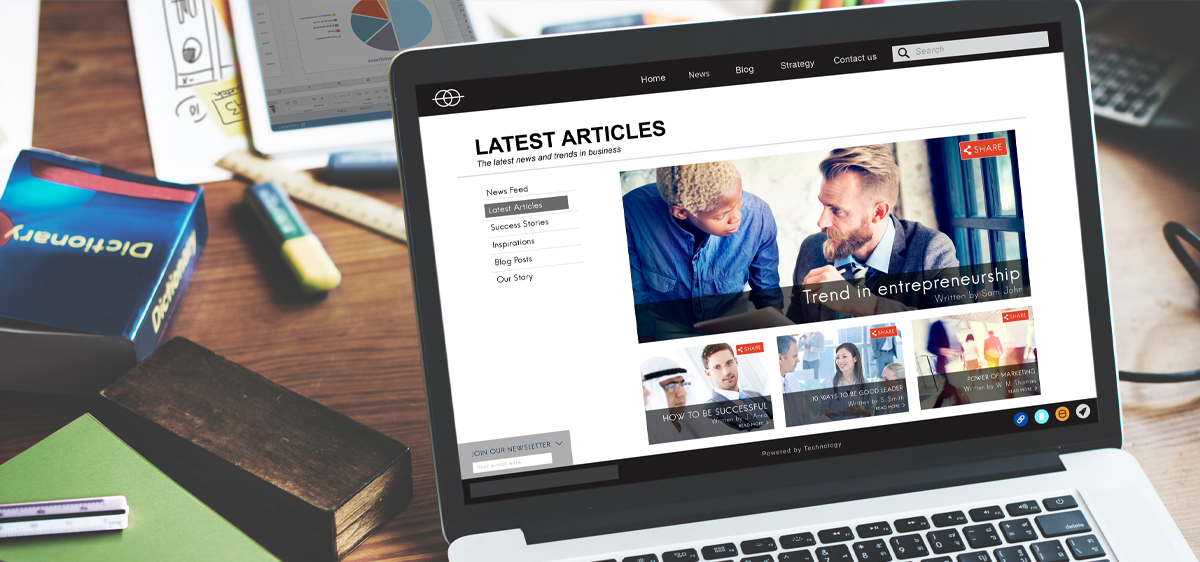
Did you miss these July business headlines? We’ve compiled the top global news stories that you need to stay in-the-know on the latest hot topics and insights from our experts. Anthony Bourdain Deepfake Controversy Points to Pitfalls of AI-Generated Content As synthetic media grows more popular as a creative tool, creators must navigate new ethical ground, reports Adweek's Patrick Kulp. David Britton, VP of Industry Solutions explains why we will see more deepfakes as the technology embeds, and how the ID & Fraud prevention and detection industry is responding. Tech-driven credit management solutions are key for businesses in post-Covid world, says new report The Business Times takes a look at how, according to Experian's latest Global Decisioning report, businesses need to respond and adapt to consumers' growing digital needs after an acceleration in digital interactions during the pandemic. Selfie biometrics for online pet sales and financial services among latest remote onboarding launches Biometric Update uncovers the latest in remote onboarding implementations, reporting on its promising steady pace and highlighting Juniper Research's recognition of Experian's industry-leading ID & Fraud solutions in this field among its peers. Validating Identities In A Digital World Bloomberg's Paul Sweeney and Matt Miller talk to David Britton, VP of Industry Solutions, in this radio piece about the importance of validating identities in a growing digital world, and what we might need to see from ID & Fraud solutions in the future to ensure that individuals are secure online. How Businesses Can Adapt to Rising Customer Expectations Donna DePasquale, EVP of Global Decisioning Software writes in CXO Today about the importance of customer journey in credit risk decision-making, taking businesses through the customer lifecycle to show how to avoid disruption during each digital interaction and touchpoint, while implementing the best decision analytics. Stay in the know with our latest insights:

Shri Santhanam, EVP and Global Head of Analytics and AI, talks to Ganesh Padmanabhan from Stories in AI about why he hopes the changing world of lending will lead to better financial inclusion. "The whole digital revolution in lending means that financial institutions are scrambling to make the process much more seamless, reduce time for approvals, let consumers have access to different financial products, and have innovative products like buy now pay later. But underneath it all, you have to get more nuanced and more sophisticated about the methodologies that you use for lending. And this is where AI and ML come in." Expect to hear discussions about the future of finance, how to drive impact by leveraging data analytics and AI, frameworks for setting up and institutionalizing an AI center of competence for a large organization, and how to scale data science efforts through hiring, promoting from within, and setting up the right structure and processes to make it happen. "Experian for over 100 years now has leveraged the power of data. We’ve been a very powerful data company. We’ve used that data to improve the lives of consumers and improve how businesses make decisions. Fundamentally, we’ve had a set of pioneers who before Big Data tech was introduced to the world, figured out that having a data marketplace or collecting high quality data on consumer lending will be of value, and that’s been the core of our business. That dynamic is changing. We see a lot of value migrating what we call up the stack. So from purely data to actually the decisions that are made with the data, to products and services in the data." Related content
